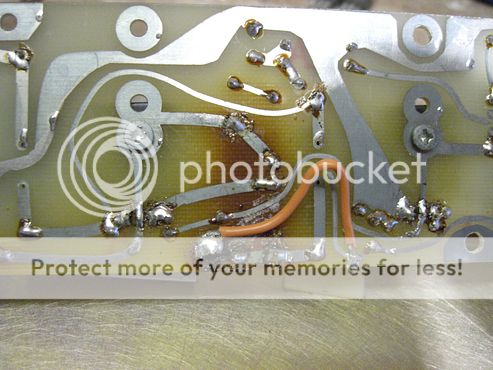colasblue
pfm Member
A friend of mine has one of these which has conked out.
I'm having a look at it and conceptually it looks quite similar to a valhalla but clearly isn't the same.
The obvious fault was that a large wirewound resistor had cooked itself off the board and disconnected from the track to the next component.
Easy fix I hoped but unfortunately not so much. I remade the connection and the resistor heated up nicely but no joy with the unit as a whole.
It looks like it's trying to work since about 80V ac appears at the output if it's switched to 33 or 45 and goes to zero if in the "off" position but it doesn't seem to have enough grunt to turn the motor. I get a bit of vibration on either setting but no rotation, and giving it a push doesn't help.
Also a 100V dc offset appears at the output on power up and then drops away quite quickly. On that basis I'm guessing some of its caps might be shot.
Anybody got a schematic or know anything helpful about them?
It has very few active components so if all else fails it's worth having a go at replacing all of them, but on the basis of what it's currently doing I think the digital side might well be working properly so it's likely a fault with the output section. I've already tried swapipng out the output transistors to no avail, mostly because I had some suitable ones in my bit box.
I'm having a look at it and conceptually it looks quite similar to a valhalla but clearly isn't the same.
The obvious fault was that a large wirewound resistor had cooked itself off the board and disconnected from the track to the next component.
Easy fix I hoped but unfortunately not so much. I remade the connection and the resistor heated up nicely but no joy with the unit as a whole.
It looks like it's trying to work since about 80V ac appears at the output if it's switched to 33 or 45 and goes to zero if in the "off" position but it doesn't seem to have enough grunt to turn the motor. I get a bit of vibration on either setting but no rotation, and giving it a push doesn't help.
Also a 100V dc offset appears at the output on power up and then drops away quite quickly. On that basis I'm guessing some of its caps might be shot.
Anybody got a schematic or know anything helpful about them?
It has very few active components so if all else fails it's worth having a go at replacing all of them, but on the basis of what it's currently doing I think the digital side might well be working properly so it's likely a fault with the output section. I've already tried swapipng out the output transistors to no avail, mostly because I had some suitable ones in my bit box.





